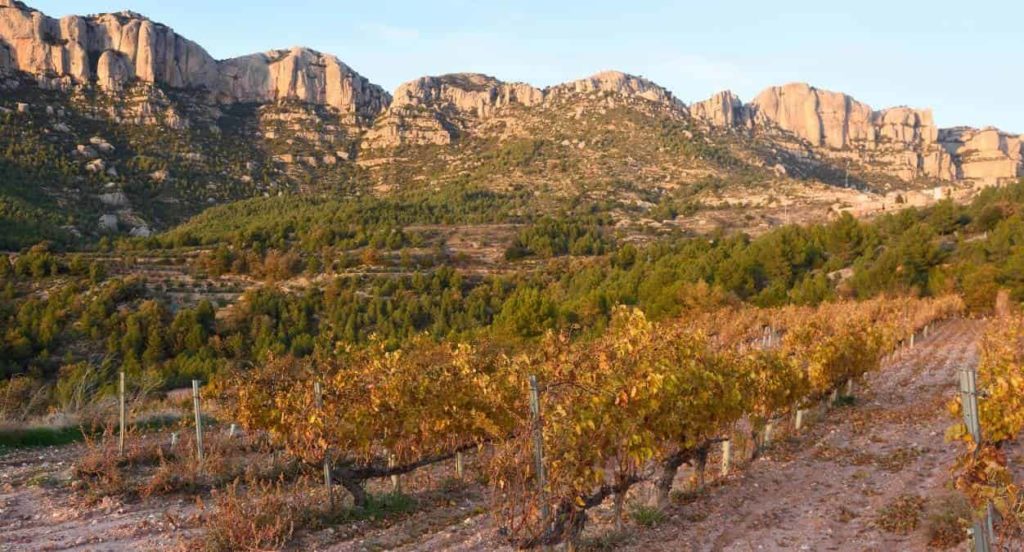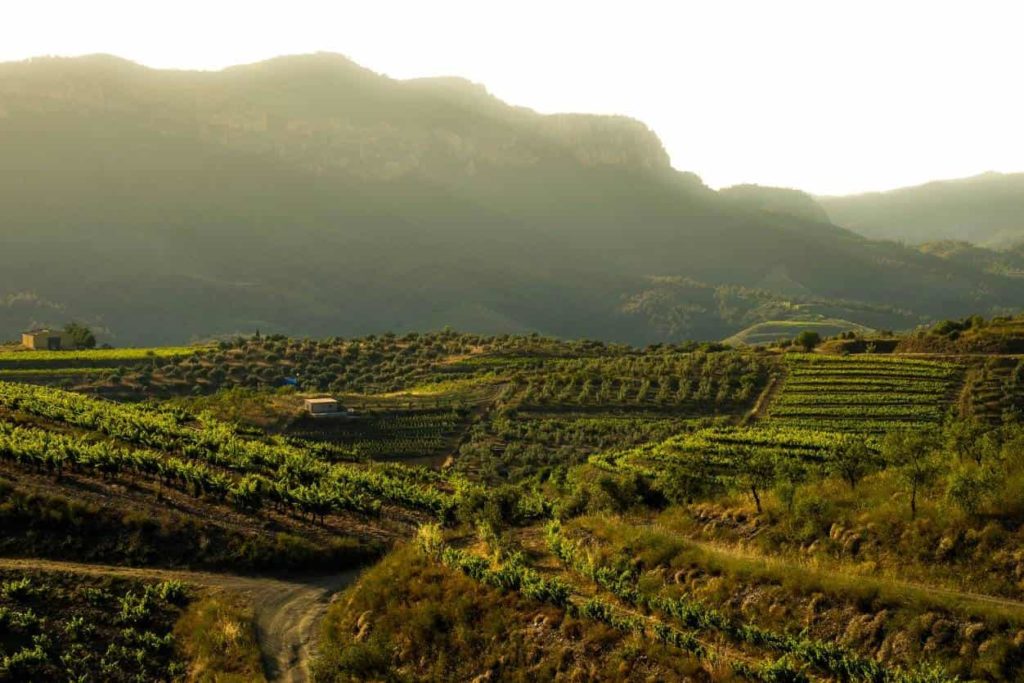
An insight into the Spanish wine regions: Priorat

Priorat is one of Spain’s great bastions of powerful and voluptuous red wines. Situated in an isolated enclave in Catalunya, the wine region is named after a monastery (priory) established by Carthusian monks in the 12th century. Yet the wine region did not become prominent until the 1990s, despite a longstanding viticultural tradition. This is partly due to the devastation by phylloxera in the late 1800s; only a trickle of unremarkable viticulture was left behind.
However, Alvaro Palacios (godfather to the luxury Spanish wine movement) arrived in the late 1980s and saw the potential of the region’s old vine ancient Garnacha vineyards. Working alongside contemporaries, he fashioned powerful and unique red wines from the best local fruit. This revelation transformed the Priorat wine region into a beacon of excellence and prestige; there are now over 1900 hectares cultivated and more than 100 wineries. Old bush vines are Priorat’s most coveted resource – they produce tiny yields on infertile, ancient soils. The result is an immensely concentrated, chewy style of Spanish wine with few parallels in Europe.
Click on a link to jump to that section:
The growing conditions in the wine region
Rescued from obscurity by Alvaro Palacios, René Barbier, and others, Priorat wine has become renowned for its exceptional quality. The vineyards are found in north-eastern Spain, less than 40km from Tarragona. Overwhelmingly planted to red wine grape varieties – a small volume of white/rosé is also made – Priorat is celebrated for its unique soils and undulating landscape; terraced vineyard sites can be seen in all directions.
Protected from inclement weather by the Sierra de Montsant, annual rainfall is often less than 500mm a year, while summer temperatures frequently exceed 35°C. This warm and dry climate is highly conducive to ripening berries packed with sugar, acids, and anthocyanins. However, the true magic of Priorat lies in the soil.
The local synonym is llicorella: dark-brown metamorphic slate that covers the vineyards in Priorat. This free-draining terroir is responsible for reflecting heat back into the vine canopy; ripeness is seldom an issue in the Priorat wine region. However, while the subsoils lack nutrients, they are both cool and damp, providing essential moisture during the summer.
Key Priorat red grape varieties
- Garnacha Tinta (Grenache) – old vines planted on cooler sites in the region yield amazingly concentrated Grenache wine, balanced freshness and acidity. Aromas of raspberry, dark cherries and thyme are usually detected – Palacios L’Ermita is the most famous example but Scala Dei, Garnatxa is a delicious, yet affordable option. Top vintages will improve in bottle for over a decade.
- Carignan (Cariñena) – the most widely planted red grape in Priorat is responsible for the appellation’s garrigue-scented red wines, noted for their flavours of cranberries and liquorice. It is often blended with Garnacha.

Other permitted varieties
Red grapes
- Cabernet Sauvignon – Priorat-grown Cabernet Sauvignon is quite distinct from the Medoc benchmark. The local grapes are rich and chocolatey, with very ripe tannins and moderate acidity.
- Cabernet Franc – the early-ripening Cabernet Franc needs a cooler site to thrive in the sweltering heat of the spanish wine region. The best wines are silky and fruit-forward, with aromas of damson and rosemary.
- Tempranillo – known as Ull de Llebre in Catalunya, Tempranillo wines made in the Priorat wine region are very concentrated examples of the genre. Expect a lot of strawberries, black cherry, and plum on the mid-palate.
- Pinot Noir – Burgundy’s star red grape can produce excellent wine at higher elevations in Priorat. They are defined by a relatively voluptuous texture and aromatic notes of crushed red berries and thyme.
- Merlot – the region trademark is a very plummy, soft, and accessible style of Merlot. Silky smooth tannins reveal flavours of blackberry and star anise.
- Syrah – a rich and voluptuous wine emerges in the hills of Priorat, renowned for its bouquet of black pepper, chocolate, and violets. These ripe, dense and potent wines always have a mineral core and beautiful freshness.
White grapes
- Garnacha Blanca – white Grenache needs a warm site to produce high-quality wine. Often blended with Macabeo and Picpoul, it can deliver full-bodied whites with a spicy finish in the region of Priorat.
- Macabeo – also known as Viura, the early-ripening variety can yield very age-worthy dry white wine in Catalunya. The vines need sufficient moisture and a relatively cool site.
- Chenin Blanc – Priorat Chenin Blanc, especially from older vines, is one of the region’s biggest surprises. The grape variety generates a delicious, honeyed, and dry white wine here.
- Xarel-lo – Cava’s finest white grape is increasingly made into excellent still wine in the vineyard sites of Catalunya. It produces a very aromatic and full-bodied style of wine: fennel is the signature scent.
- Picapoll Blanco – popular in the Languedoc-Roussillon, Picpoul has also found a welcome home in the slate soils of the Priorat region. Citrus and mineral notes are part of the course.
- Viognier – rich and voluptuous, low-yielding wines with apricot and orange blossom aromas can be produced in a handful of worthy sites in the Priorat region.
Priorat wine designations/classifications
Priorat winemakers in the region are proud of their vineyard-designated wines: the Spanish wine regulations divide Priorat into 12 village zones or Vi de Vilas. This was introduced in 2009 following a study of the region’s different soils and mesoclimates. Priorat recently unveiled a quality pyramid in 2019 that closely mimics the Burgundy model.
The top wines of Priorat are classified as Gran Vinyas, including Alvaro Palacios, l’Ermita, Clos Erasmus and Tossal d’en Bou. One step down are the Vinya Classificada wines, including Clos Mogador, Mas Martinet, and Mas Doix. Many producers adhere to this quality guide in Priorat.
Although, there are many DOQ Priorat labels, such as Scala Dei, that offer quality at a lower price point.
However, the region also maintains a hierarchy based on the length of ageing in oak barrels and in bottle. According to the regulations, ‘Vino de guarda’ wines must spend a minimum of 12 months in oak before bottling. The three-tier classification also lists Crianza, Reserva, and Gran Reserva wines in ascending order of quality.
- Crianza: wines must be at least two years old before release. They are aged for a minimum of six months in oak and the remainder in bottle.
- Reserva: wines must be at least three years old before release. They are aged for a minimum of one year in oak and the remainder in bottle.
- Gran Reserva: wines must be aged for a minimum of two years in oak and three years in bottle.
In addition, the term ‘Fermentado en Barrica’ on the label indicates that the wines have been fermented or aged in 600 litres or fewer barrels.
Alternative Priorat wine styles
Priorat is mainly associated with concentrated and structured Spanish red wine, much admired for its minerality and purity. Yet, there are a few surprises in Priorat, not least a small volume of excellent white wines. A longstanding tradition of producing fortified styles has also survived into the 21st century. Priorat Vino Rancios (oxidised wines aged for five years in glass demijohns) can be delicious, especially around the festive season. Meanwhile, ‘Vino de Licor Dulce’ is a sweet, fortified wine with a minimum alcohol of 15%. Winemakers use grape spirit to arrest the fermentation, leaving some residual sugar in the wine.
Enjoying Priorat wine
Every year brings good news for investors in Priorat. This once quiet corner of Spain is no longer an insider secret. Priorat wines are now gaining popularity to rival La Rioja, although Priorat exports a fraction of its competitor’s total output. Few can resist the concentrated, dark fruit profile that defines the region’s exquisite red wine.
However, Priorat wine is not overpowered by fruit. In fact, the Garnahca here offers the same fruity, floral spiciness as top-notch Châteauneuf-du-Pape. Food and wine pairing options are also abundant in the region. Slow-cooked ox cheek is an excellent choice, as is venison, well-hung game, and hard cheeses – Cheddar is sublime. Incidentally, the Catalans enjoy their Priorat with richly flavoured roasts: the wines can stand up to wild boar, lamb, or whole suckling pig.




